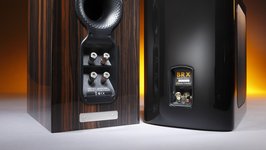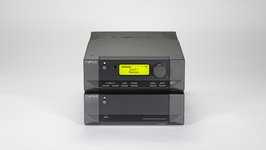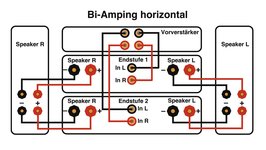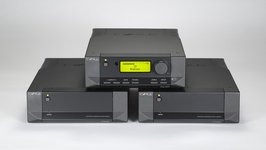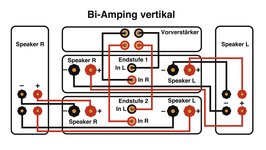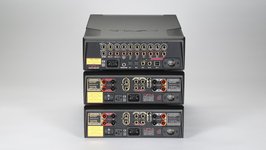
Service
Everything You Need to Know About Bi-Amping
To Bi Or Not To Bi – Bi-amping is considered one of the "ultimate aspects" of sophisticated high fidelity. In this essay, you'll read what it is exactly, how it works and what the benefits are.
The amplifier is the central point of every hi-fi setup – no matter if in the integrated form, or as a receiver with radio section; or separated into the switching-regulating, voltage-amplifying preamplifier section for connecting sources and the current-amplifying power amp section for feeding loudspeakers. So far, so good. Most systems for listening to music, almost all really, have and need only one amplifier to do their job.
In order to explain why it can sometimes make sense to divide the amplification work among several devices – when higher and highest demands are made of the sound –, we'll have to elaborate a bit.
Imagine a person who wants to transport a small piece of furniture, let's say a chair. Maybe even two. To comfortably do that is usually no problem. But if the same person has to carry a piano up to the third floor of a building – well, a second person will certainly be needed, no matter how strong any of them might be.
Usually, every hi-fi system with passive loudspeakers is driven by an amplifier with the necessary power.
The operation of multiple amplifiers, also called bi-amping, now comes into play: it helps to increase the sovereignty of the task compared to the "usual" performance, by distributing parts of said task to various places. If you operate a very small system, this is probably just as unimportant as a 1000 Euro power cable might be. Starting at a certain degree of complexity and difficulty of the task, however, teamwork makes sense – in the realm of driving the speaker, namely. Besides, it also (usually) sounds better.
Bi-Amping, A Definition
Starting with the basics: there is a rough distinction between the widespread "passive" and the much rarer "active" operation of loudspeakers, i.e. passive and active speakers.
In the "usual case" already outlined above, the amplifier drives the passive speakers from the outside. Dividing the frequency ranges takes place only via passive components – the crossover – in the speaker itself.
This is inevitably accompanied by losses: both power and damping factor (control) are lost, and in addition, some interactions between the signals may happen. The large woofer, for example, is equipped with a powerful voice coil. This pumps violently against the amplifier via the so-called "back EMF" and thus influences, even impairs, the mid-high section.
You probably already know how this looks in an active loudspeaker. There, on the other hand, the individual frequency ranges are driven by amplifier stages that are usually integrated into the housing. An electronic crossover or a digital signal processor sits BEFORE the power amplifiers, and these give energy to the individual drivers. In addition, a very fine adjustment to the respective loudspeaker driver can be made, differences in running time can be equalized via DSP, or even sonic problems of the room can be addressed, etc. The frequency ranges also interact less with each other.
British engineers are usually credited with a fitting solution: namely, that even when using passive loudspeakers, a (small) part of the signal reproduction can be improved. That is done by using separate cables for bass and mid-high reproduction when exiting the amplifier, the so-called "bi-wiring". This reduces the intermodulation present in the respective cables. In the cable for the mid-high range, for example, the aforementioned distortions caused by the voice coil of the woofer are effected. At the same time, the cable diameter is increased, which reduces loss. This has long been proven by measurements. If you are interested in this topic, you should take a closer look at the measurement series done by QED/Q Acoustics (see link under "Further Reading").
You could certainly consider bi-amping as a kind of extended bi-wiring. One that offers a kind of compromise between passive and active operation; or alternatively a more advanced intermediate stage between these: two or more amplifiers share the job, but the loudspeaker remains passive by definition. This is due to the fact that the passive crossover, which splits the frequencies to the individual drivers, remains. If you operate an active subwoofer together with passive speakers, you basically already have a bi-amping setup.
Preparation for Bi-Amping
In order to even consider classic bi-amping, the speakers you use must necessarily have a bi-wiring terminal. That means they have to allow the connection of separate cables for the woofers and midrange driver/tweeter and the fitting frequencies. A cable or sheet metal bridge must absolutely be removed if you want to start and have such an accessory installed.
In addition, of course, you need at least two suitable amplifiers. If you want to use an integrated amplifier, it must either have preamplifier outputs to which you can connect a second power amplifier – or the possibility must be given to separate the preamplifier and the power amplifier so that you can connect both the built-in and the external power amplifier in parallel. You need double speaker cables and interconnects that are as identical and long as possible, as well as "Y" cable-adapters for entering the power amplifiers, if necessary.
As a basis, it is advantageous to use the same or at least very similar amplifiers for bi-amping. Thus, a certain electrical and tonal homogeneity is maintained. The amplification factor must be identical or at least adjustable to the same level, in order to achieve identical output levels. This is also the reason why we recommend to stay with the same manufacturer if possible: there, the input sensitivities, impedances and amplification factors are usually identical.
Of course, completely exotic combinations are also possible – you could use a 600-watt transistor power amp from manufacturer A for the bass range and a low-power integrated tube amp from brand B for the rest. The resulting degree of freedom can work by chance, but it can also – sorry – turn out horribly bad.
Thus, the cabling and combination of the devices are crucial for the result. We carried out our practical tests with components kindly provided to us by Cyrus (through the German distributor Bellevue Audio): the Pre2 DAC, 82 DAC and 2 x Cyrus X Power; as well as high-quality Silent Wire cables of the "12 Cu" series. When going with Cyrus, integrated and power amplifiers can be combined almost completely at will. Even older components have the same amplification factor, so that one can, for example, operate a 20-year-old integrated amp with modern stereo or mono amplifiers of different output power without any problems. Not to mention the pleasing compactness and well-known musical sound quality.
The Choice is Yours
Essentially, there are two different styles of bi-amping operation: horizontal and vertical (see diagrams in the image gallery above).
In horizontal bi-amping, one stereo power amplifier controls the bass of both channels (i.e. speakers) and the other the mid-high range of both channels. This variant – and only this one – also works when using an integrated amp plus an additional power amp. You can also use differently powerful amplifiers, but it makes sense to mostly use the more powerful one for the low frequency range, since it "needs" considerably more power.
When wanting to set up vertical bi-amping, on the other hand, two completely identical amplifiers are required. In our example, we need two identical Cyrus X Power amps, because one stereo power amp drives the left channel and one the right channel. Indeed, that means that one of them drives the respective speaker completely alone, so that one speaker "claims" a stereo power amplifier for itself.
If you have two identical stereo power amps, you can of course wire them to the speakers in both of these ways. In this case, the sources are connected to the preamplifier as is normal, and the preamplifier outputs are connected to the power amplifiers. If there is only one pair of preamp outputs, you may have to use Y-cables or adapters.
Speaking of cabling, this aspect should be done carefully and calmly and checked again afterwards. Errors rarely lead to defects here – unless you leave the cable bridges in the speaker terminals – but they can very well lead to strange effects if you try to adjust the balance.
Thoughts and Experiences
A question may now arise, but the answer will not be definite: whether the horizontal or the vertical system is the better one in terms of sound quality, if both are available. Unfortunately, the results are varying between the options, depending on different constellations and the type of amplifier and loudspeaker load.
The technological advantage of horizontal operation is undoubtedly the very even load distribution on both channels and the amplifier power supply. In vertical bi-amping, of course, the enormous channel separation plays a role and can pay off in improving the plasticity of the reproduction. That stems from the fact, you guessed it already, that a complete amplifier feeds only one speaker, i.e. the entire left or right channel.
In my personal experience, this vertical arrangement and the resulting "quasi" mono operation is indeed usually preferable. It is, however, also more susceptible to "dynamic" crosstalk, at least in theory. That might happen, if, for example, enormous power requirements in the bass provide a very uneven load on the channels in the amplifier. That can then also lead to problems in the less busy mid-high branch of the same speaker.
If you have four mono power amplifiers, the distinction between horizontal and vertical no longer makes sense. This would also be the best way to deal with the crosstalk of any channel, which no longer exists in the power section. It would also make the choice of cabling unnecessary, because the results are always completely identical – assuming a low level of manufacturing variation.
Now, you, the attentive reader, might ask the next question: wouldn't setting up a preamplifier and two (not four) mono power amps be generally better than bi-amping by means of stereo power amps? The question would also have to be answered with the same "it depends".
Mono amplifiers often have enormous power. This may be necessary in large rooms, with low efficiency or particularly power-hungry speakers, or when hosting a party. In most other cases, however, I would personally prefer bi-amping. I would even go so far as to recommend buying two stereo versions of the second-best power amp rather than one of the best device from the same brand, and running these in a bi-amping setup. In most cases, you will achieve an even slightly better result. Or you could still choose the top model and save to get a second one of that. All this is no problem with bi-amping.
Basically, at least in theory, the combination of preamplifier and power amplifier is superior to the integrated amplifier concept. The weak preamplifier signals are processed separately from the current-filled power amp signals. They can't enact any negative influences on each other as they aren't in the same cabinet. This theoretical difference remains to a certain extent when setting up bi-amping.
Nevertheless, the operation of an integrated amplifier with a power amplifier might only be ever so slightly worse, surprisingly. It is also possibly the economically more reasonable variant. One can start with the integrated amplifier and upgrade from there on, or when higher demands develop, for example. This is what many customers do with the very compact Cyrus amps, in staying with our example. The operation of two Musical Fidelity M8xi integrated amplifiers enables an extremely attractive upgrade path with two instead of three devices – thanks to corresponding connections – as well, to name another one.
From this point of view, bi-amping can be seen as an act of "tuning" that is worth some consideration. At least as long as your existing or desired speaker has a bi-wiring terminal. There are indeed loudspeaker manufacturers who do not like letting the division of labor realized by their complex crossover be interfered with. Dynaudio and Focal, for example, deliberately do without the double connection. A decision that we respect.
Technical Problems
In the history of STEREO, spanning a few decades, we have had various bi-amping specials. In these, one possible problem has already been pointed out. In a bi-amping setup, the complex loudspeaker load is split into a predominantly inductive (bass) and a predominantly capacitive (treble) load. If the amplifier used is extremely load stable, this will hardly be noticed.
I myself am the specialist for hi-fi classics here at STEREO. Expectedly, I have been operating – in alternation with modern devices – numerous older power amplifiers of various manufacturers in vertical bi-amping for more than two decades now. This includes components from Carver, Cyrus, GAS, SUMO, as well as professional-grade, 2-ohm-stable QSC USA 1310 and two Sansui AU-X1 integrated amps as power stages. These were even "allowed" to drive the extremely impedance-critical Infinity IRS at the German magazine "HiFi Stereophonie", which existed until 1985. Practically never did I have a problem with such transistor monsters.
Nevertheless, especially tube and switching amplifiers (Class D) sometimes have certain difficulties with jumps in impedance. This is especially true when the inductance of the mid-high section is lost. When that happens, some amplifiers literally seem to lack traction. This does not necessarily mean that class D or tube technology has to be abandoned in bi-amplification, however.
To restabilize the conditions, simply connect a harmless LR element to the tweeter section of the speaker. That is a small inductive coil (a few millihenry) and a medium, two-digit ohmic resistor following it. You simply connect it in parallel to the mid-high terminal.
This can help. It "grounds" the amplifier again in the figurative sense. It can also provide a much more relaxed, confident and, above all, homogeneous, unbroken sound. With this, Manfred Diestertich from Audio Physic has already brought slightly inhomogeneous tube amplifier-loudspeaker combinations – in bi-amping mode – "back into line" at trade fair demonstrations of days past. It even did more than that, indeed, the trick made them "take off".
And while we're at it: Ingo Hansen – boss of the company Phonosophie and one of the most experienced bi-amping experts that we have here in Germany –, believes that a level adjustment between bass and mid-high range is also desirable.
Thus, he adjusts both frequency ranges in his devices up to a point of 0.25 dB to fine-tune the sound. If the power amplifiers used for the multi-amplifier operation have input controls, you of course also have this possibility, even if the steps are perhaps somewhat less fine.
Thus, bi-amping, apart from the disadvantages concerning the cost of equipment and cables, is an almost infinitely multifaceted "playground". It can lead to a worthwhile to enormous sonic enrichment for many systems. Bi-amping brings more power into your setup. This leads to more breath, pressure and control. Especially the mid-high range gets more power, as the additional power that would otherwise be used for the bass remains as a reserve, considering that it is not (or no longer) used. The amplifier branch responsible for the bass, whether horizontal or vertical, also gets additional reserves, of course. You can hear the results, try it out! To BI Or Not To BI – "No Question" for me. Have fun!
Test Devices
CD Player:
Cyrus DAD 3 Q24/PSX-R
Amplifiers:
Cyrus Pre2 DAC,
Cyrus 82 DAC,
Cyrus X Power
Loudspeakers:
DALI Epicon 6,
Spendor S3/5,
Visaton Vox 252
Cables:
Silent Wire 12 Cu
For Further Reading
Bi-Wiring Loudspeakers: Research and Benefits
We also thank Bellevue Audio and Silent Wire for their kind support:
Bellevue Audio GmbH (German Website)
Silent Wire – German Cablemanufacture Hermannsburg
 MAGAZINE
MAGAZINE